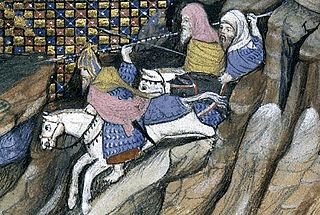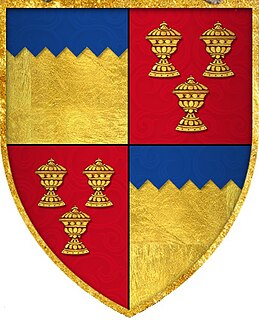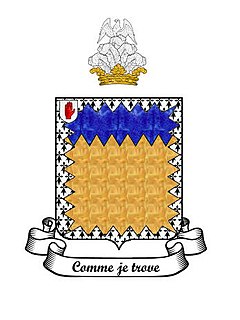Related Research Articles

Sir Anthony St Leger, KG, of Ulcombe and Leeds Castle in Kent, was an English politician and Lord Deputy of Ireland during the Tudor period.
Diarmait Mac Murchada, anglicised as Dermot MacMurrough, Dermod MacMurrough, or Dermot MacMorrogh, was a King of Leinster in Ireland. In 1167, he was deposed by the High King of Ireland, Ruaidrí Ua Conchobair. The grounds for the deposition were that Mac Murchada had, in 1152, abducted Derbforgaill, the wife of the king of Breifne, Tiernan O'Rourke. To recover his kingdom, Mac Murchada solicited help from King Henry II of England. His issue unresolved, he gained the military support of the 2nd Earl of Pembroke. At that time, Strongbow was in opposition to Henry II due to his support for Stephen, King of England against Henry's mother in the Anarchy. In exchange for his aid, Strongbow was promised in marriage to Mac Murchada's daughter Aoife with the right to succeed to the Kingship of Leinster. Henry II then mounted a larger second invasion in 1171 to ensure his control over Strongbow, resulting in the Norman Lordship of Ireland. Mac Murchada was later known as Diarmait na nGall. He was seen in Irish history as the king that invited the first-ever wave of English settlers, who were planted by the Norman conquest. The invasion had a great deal of impact on Irish Christianity, increasing the de facto ability of the Holy See to regulate Christianity in Ireland.
Richard de Clare, 2nd Earl of Pembroke, Lord of Leinster, Justiciar of Ireland, also known as Richard FitzGilbert, was an Anglo-Norman nobleman notable for his leading role in the Anglo-Norman invasion of Ireland. Like his father, Richard fitz Gilbert has since become commonly known by his nickname Strongbow, which may be a mistranscription or mistranslation of "Striguil".

Art Óg Mac Murchadha Caomhánach was an Irish king who is generally regarded as the most formidable of the later kings of Leinster. He revived not only the royal family's prerogatives, but also their lands and power. During his 42-year reign, he dominated the Anglo-Norman settlers of Leinster. His dominance of the province and its inhabitants, both Gaelic and Hiberno-Norman, was deemed sufficiently detrimental to the colony that Richard II of England spent much of the years 1394 and 1395 sparring with him. While MacMurrough-Kavanagh did eventually submit to Richard, he renounced this fealty on Richard's departure and made much of his kingdom a death trap for any invading English or Anglo-Irish forces. The Crown accordingly dealt with him cautiously and he was granted an amnesty in 1409.

Piers Butler, 8th Earl of Ormond, 1st Earl of Ossory also known as Red Piers, was from the Polestown branch of the Butler family of Ireland. In the succession crisis at the death of Thomas Butler, 7th Earl of Ormond he succeeded to the earldom as heir male, but lost the title in 1528 to Thomas Boleyn. He regained it after Boleyn's death in 1538.
The Second Desmond Rebellion (1579–1583) was the more widespread and bloody of the two Desmond Rebellions in Ireland launched by the FitzGerald Dynasty of Desmond in Munster against English rule. The second rebellion began in July 1579 when James FitzMaurice FitzGerald landed in Ireland with a force of Papal troops, triggering an insurrection across the south of Ireland on the part of the Desmond dynasty, their allies, and others who were dissatisfied for various reasons with English government of the country. The rebellion ended with the 1583 death of Gerald FitzGerald, 14th Earl of Desmond, and the defeat of the rebels.

Murrough O'Brien, 1st Earl of Thomond was the last King of Thomond, and a descendant of the High King of Ireland, Brian Boru.

Caomhánach is an Irish language surname first assumed by Domhnall Caomhánach, eldest son of the 12th century Diarmait Mac Murchada, king of Leinster. A considerable number of anglicised variations of Caomhánach exist; some of the most common are Kavanagh, Cavanagh, Kavanaugh and Cavanaugh.
Elizabeth le Veel, also known as Elizabeth Calf, was an Anglo-Irish noblewoman, and wife of Art mac Art MacMurrough-Kavanagh, King of Leinster. Her marriage to Art violated the Statutes of Kilkenny, and resulted in her property being forfeited to the English crown. This caused her husband to declare war in Ireland against the forces of King Richard II of England.
Connor O'Brien, 3rd Earl of Thomond also spelt Conor and called Groibleach, or the "long-nailed", fought his uncle Donnell over his father's succession during thirty years from 1535 to 1565. He was confirmed as 3rd Earl of Thomond in 1558 by the Lord Deputy of Ireland, Thomas Radclyffe, 3rd Earl of Sussex. O'Brien intrigued with fitz Maurice in 1569 during the 1st Desmond Rebellion and fled to France. He returned and was pardoned in 1571, being restored to his lands at the end of the rebellion in 1573.

There were six early Barons Inchiquin in Ireland between 1543 and 1654. The title was granted to Murrough O'Brien, the brother of Conor O'Brien, King of Thomond, when he surrendered his Irish royalty to King Henry VIII in 1543. His descendants held the title until 1654, when Murrough O'Brien, 6th Baron Inchiquin was created Earl of Inchiquin.

Gerald FitzMaurice, jure uxoris 1st Lord of Offaly was a Cambro-Norman nobleman who took part with his father, Maurice FitzGerald, Lord of Llanstephan, in the Norman Invasion of Ireland (1169–71). Together with his five brothers and one sister Nesta they founded the notable FitzGerald/FitzMaurice dynasty which was to play an important role in Irish history.
Sir James Butler of Polestown was a warlord in Yorkist Ireland.

Sir Theobald Butler, 1st Baron Cahir, Caher, or Cahier was the first baron Cahir of the second creation, which occurred in 1583.

Sir Thomas Butler, 1st Baronet of Cloughgrenan (c.1578-1642), was an Irish nobleman, the illegitimate son of Sir Edmund Butler of Cloughgrenan (1534-c.1585) and grandson of James Butler, 9th Earl of Ormond and 2nd Earl of Ossory (c.1496-1546).

The Barony of Ballyane is a Barony in County Wexford Republic of Ireland. It was "surrendered and regranted" by the Clan Kavanagh in 1543. Diarmait Mac Murchada, King of Uí Cheinnsealaig and king of Leinster held the lands of the Barony of Ballyane in 1167. His clan of MacMurrough-Kavanagh began to regain some of their former territories in the 14th century, especially in the north of the county, principally under Art MacMurrough Kavanagh. He extended their territories and exercised control over County Wexford and over County Carlow which is located in the province of Leinster. In pre-Norman times Leinster was part of the Kingdom of Uí Cheinnsealaig, whose capital was at Ferns.
Sir William Brabazon, was an English-born soldier and statesman in Ireland. He held office as Vice-Treasurer of Ireland and Lord Justice of Ireland. His descendants still hold the title Earl of Meath.

James fitz John FitzGerald, 13th Earl of Desmond, also counted as the 14th, owned large parts of the Irish province of Munster. He was appointed Lord Treasurer of Ireland in 1547.
Events from the year 1554 in Ireland.
Robert Preston, 1st Baron Gormanston was an Anglo-Irish nobleman, statesman and judge of the fourteenth century. He held several senior judicial offices including, for a brief period, that of Lord Chancellor of Ireland. He was the founder of the leading Anglo-Irish Preston family whose titles included Viscount Gormanston and Viscount Tara.
References
- Attribution
![]() This article incorporates text from a publication now in the public domain : Dunlop, Robert (1892). "Kavanagh, Cahir Mac Art". In Lee, Sidney (ed.). Dictionary of National Biography . Vol. 30. London: Smith, Elder & Co.
This article incorporates text from a publication now in the public domain : Dunlop, Robert (1892). "Kavanagh, Cahir Mac Art". In Lee, Sidney (ed.). Dictionary of National Biography . Vol. 30. London: Smith, Elder & Co.